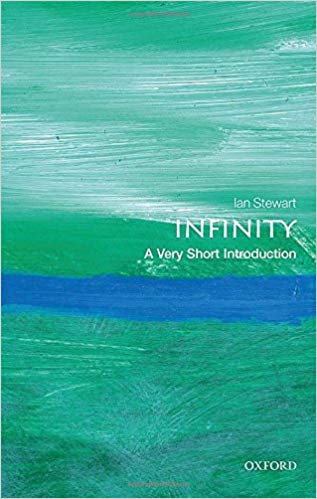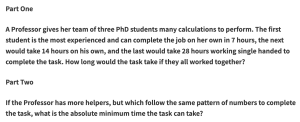Review: The Very Short Introduction
Infinity, A Very Short Introduction, by Ian Stewart
This review was originally written for the London Mathematical Society November 2018 Newsletter. The book can be found here.
The “Very Short Introduction” series by Oxford University Press attempt to take a moderately deep dive into various subjects in a slimline volume. Professor Stuart addresses the apparent paradox of tackling the subject of the infinite in such a small volume right at the start, along with the observation that the topic of infinity has long provided such paradoxes. This particular VSI aims to tackle infinity as found in numbers, geometry, art, theology, philosophy and more, and so it is a tightly packed volume indeed.
Infinity is a concept that is, at least now, embraced in Mathematics, but also reaches into Physics, Philosophy, Theology and Language in significant measure. In this book, Ian Stewart sets off almost immediately into the mathematical interpretations and concepts of infinity, starting with examples that are likely to be accessible to a wide range of readers, but also touching on some that will cause more mathematically advanced readers to consider them carefully and which may be challenging to less mathematically literate readers.
These examples are of the paradoxical issues surrounding infinity; all but one of these is explicitly mathematical, some geometrical, others more algebraic; by the end of the first short chapter we have visited David Hilbert’s famous hotel and explored some of the implications for the arithmetic of the infinite.
Hilbert's Infinite Hotel - 60-Second Adventures in Thought (4/6)
A never-ending hotel, always full of guests, helps to explain the nature of infinity. (Part 4 of 6) Playlist link - https://www.youtube.com/playlist?list=PL73A886F2DD959FF1 Transcript link - http://podcast.open.ac.uk/feeds/thoughtexperiments-01/transcript/60second04_01691_16696.pdf Study a free course on Introducing philosophy at the Open University https://www.open.edu/openlearn/history-the-arts/culture/philosophy/introducing-philosophy/content-section-0?active-tab=description-tab Study R14 BA (Honours) Arts and Humanities (Philosophy) http://www.open.ac.uk/courses/qualifications/r14-p Explore qualifications in Philosophy with the OU http://www.open.ac.uk/courses/find/philosophy The Open University is the world's leading provider of flexible, high-quality online degrees and distance learning, serving students across the globe with highly respected degree qualifications, and the triple-accredited MBA.
The second chapter then moves into a more detailed exploration of the consequences of the infinite in numbers, and in particular explores the infinite, non-repeating decimal representations of irrational numbers and the continuity of the real numbers.
Stewart then explores the history of the infinite in the third chapter, and how it weaved through early Greek philosophy and the classic paradoxes of Zeno, and how for the Greeks issues of infinity were closely tied to their thoughts and theories about motion, and indeed whether motion was in fact possible or an illusion. Some time is spent with Aristotle, and how he dismissed the idea of an “actual” infinity in favour of a “potential” infinity. We then move through with both Locke and Kant to the beginning of more modern philosophical analyses of the infinite. Some time is taken to explore the philosophy of the infinite in Christian theology, particularly through Thomas Aquinas, a philosopher heavily influenced by Aristotle and how he used the infinite in his “proof” of God.
Zeno's Paradox - Numberphile
Dr James Grime is back and talking about tortoises.
Stewart also explores how, in the modern era, mathematicians take the infinite very much as a normal and integral part of mathematics, with little concern about the distinction of actual and potential infinities that were the great concern of the philosophy of the ancient world.
We dive then, from the infinitely large to the infinitely small in the fourth chapter where the seeds of calculus and analysis are to be seen, and the philosophical objections from Bishop Berkeley to the use of infinitesimals. It is interesting to note that these and other concerns about the theoretical underpinnings of calculus were largely ignored in the face of its obvious utility, until others tried to explore these foundations more deeply. Stewart takes us through this work through Cauchy and eventually to the work of Bolzano and Weierstrass who finally introduced the ? and ? notation that has undoubtedly delighted many undergraduates since and ushered in the start of analysis proper. Stewart than dips into an examination of non-standard analysis, a topic that at least I was never knowingly exposed to in my formal studies; it was intriguing to read of these numbers with “standard” and “infinitesimal” parts.
There follows a chapter on the geometrically infinite, which in particular looks at the role of the infinite in art, but which again after an informal discussion dips into the mathematics of what is going on. The chapter after this focuses on infinities that arise in Physics, particularly in optics, Newtonian and Relativistic gravity, moving on then to discuss the size of the known universe and its curvature. These two chapters are both short and may require some unpacking by readers with less background knowledge.
The final chapter is mostly dedicated to work of Cantor and his systemization of modern mathematical thinking around the concept of the infinite. Here we meet the distinctions between the finite, countably infinite and uncountably infinite, transfinite cardinals and transfinite ordinals. But even here we find the objections of some philosophers, in this case Wittgenstein. This is interesting to read in an era where Cantor’s formulations are considered uncontroversial and part and parcel of the “paradise” of Hilbert’s modern mathematics in the same way that the past controversies of complex numbers are of little interest to modern mathematicians.
The approach taken to infinity in the book, is non-apologetically Pure Mathematical in its spirit, and I suppose this may make the work a little less accessible for some readers, particularly those who are not prepared to think through some of the sections, perhaps with a pen and paper. The Very Short Introduction to Mathematics, from the same series, by Timothy Gowers similarly tackles a cross section of challenging examples from the discipline in a relatively small space.
In September 2016, the BBC aired an interesting series on Radio 4: “The History of the Infinite” (this is still happily available online for those interested, at least for those in the UK). In this series, Adrian Moore began discussing the original Greek antipathy to the idea in early philosophy, and then how the idea emerged through Aristotelian Philosophy, Christian theology. It was after this that Moore decided to tackle the more serious implications of the infinitely small and big in mathematics, before emerging back through Physics into more philosophical territory.
I suspect this route, sandwiching the more complicated mathematical treatment between philosophy more related to human experience could be more palatable to a general reader.
The Very Short Introduction to Infinity is nevertheless a fascinating and joyful exploration of the topic, accessible to the committed and careful novice, but with enough detail and asides to delight formally mathematically trained readers.


